![]()
![]()
![]()
Use LEFT and RIGHT arrow keys to navigate between flashcards;
Use UP and DOWN arrow keys to flip the card;
H to show hint;
A reads text to speech;
77 Cards in this Set
- Front
- Back
- 3rd side (hint)
|
Abdomin/o |
Abdomen |
|
|
|
Anter/o |
Front |
|
|
|
Brachi/o |
Arm |
|
|
|
Cardi/o |
Heart |
|
|
|
Caud/o |
Tail |
|
|
|
Cephal/o |
Head |
|
|
|
Cervic/o |
Neck |
|
|
|
Chondr/i |
Cartilage/gristle |
|
|
|
Cran/o, crani/o |
Skull |
|
|
|
Cyt/o |
Cell |
|
|
|
Dist/o |
Distant |
|
|
|
Dors/o |
Back |
|
|
|
Femor/o |
Thigh, femur |
|
|
|
Gastr/o |
Stomach |
|
|
|
Glute/o |
Buttock |
|
|
|
Hom/o home/o |
Same |
|
|
|
Ili/o |
Flank, hip, groin |
|
|
|
Infer/o |
Below |
|
|
|
Inguin/o |
Groin |
|
|
|
Later/o |
Side |
|
|
|
Lumb/o |
Loin, lower back |
|
|
|
Medi/o |
Middle |
|
|
|
Organ/o |
Tool |
|
|
|
Pelv/o |
Bowl, basin |
|
|
|
Physi/o |
Nature |
|
|
|
Pleur/o |
Pleura, rib |
|
|
|
Poster/o |
Back |
|
|
|
Proxim/o |
Near |
|
|
|
Super/o |
Above |
|
|
|
Thorac/o |
Chest, thorax |
|
|
|
Tom/o |
To cut |
|
|
|
Umbilic/o |
Navel, umbilicus |
|
|
|
Ventr/o |
Belly |
|
|
|
Anatomy |
The study of body structure |
|
|
|
Homeostasis |
Sameness,unchanging |
|
|
|
Atom |
Simplest building block of the body |
|
|
|
Molecules |
When atoms bind together. |
|
|
|
Organelles |
Nonliving structures, parts of cells |
|
|
|
Cell. |
Most basic life form of body. Form tissue |
|
|
|
Types of tissues |
Epitheal, connective, muscle, and nervous |
|
|
|
Organ |
Maintains a certain shape and performs a function |
|
|
|
System |
A grouo of organs sharing a general function. |
|
|
|
Cardiovascular system |
Major arteries, heart, major veins Transport substances to and from body cells |
|
|
|
Lymphatic System |
Tonsils,thymus,lymphatic vessels, spleen, lymoh nodes. Remove unwanted substances and recycle fluid to the blood. |
|
|
|
Respiratory system |
Pharynx, nose, larynx, trachea, bronchi, lungs. Exchange gases between the external environment and blood |
|
|
|
Digestive System |
Pharynx. Mouth. Salivary glands. Esophagus. Liver. Stomach. Gallbladder. Pancreas. Colon. Small intestine. Prepare foods for absorption into bloodstream and eliminate solid wastes |
|
|
|
Urinary system |
Kidneys. Ureters. Urinary bladder. Urethra. Remove nitrogenous wastes and excess water and salts from the blood stream. |
|
|
|
Female reproductive system |
Mammary glands, fallipian tube, uterus, ovary, vagina. Provide for creatio. Of new individuals |
|
|
|
Male reproductive system |
Vans deferens, prostate, testis, urethra, penis. Creation Of new individuals. |
|
|
|
Nervous system |
Brain, spinal cord, nerves. Control homeostasis by sensing changes in the environment, processing info, initiating body responses |
|
|
|
Endocrine system |
Pituary gland, thyroid gland, thymus, adrenal glands, pancreas, ovary, testis. Control homeostasis by releasing hormones into the bloodstream,which alter body functions |
|
|
|
Muskoskeletal system |
Bone, muscle, joint, tendon. Movement. |
|
|
|
Integumentary system |
Hair, skin, nails. Protect from fluid loss,injury, infection |
|
|
|
Superior |
Toward the head, or upper part of body |
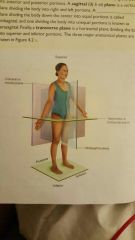
|
|
|
Inferior |
Away from the head, or lower part of body |
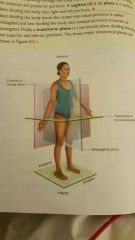
|
|
|
Anterior |
Toward the front or belly |
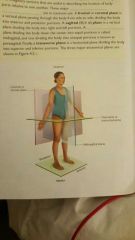
|
|
|
Posterior |
Toward the back |
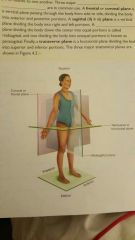
|
|
|
Medial |
Toward the midline. Belly button |
|
|
|
Lateral |
Toward the side. |
|
|
|
Superficial |
External, toward the body surface |
|
|
|
Deep |
Internal. Inward from the surface |
|
|
|
Proximal |
Toward the origin of attachment to trunk. |
|
|
|
Distal |
Away from the origin of attachment to the trunk |
|
|
|
Frontal/cornal plane |
Vertical plane passing through body from side to side. Dividing anterior from posterior. |
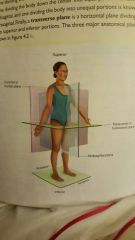
|
|
|
Sagital plane |
Dividing right and left portions of the body. Midsagital= equal portions Parasagital=unequal |

|
|
|
Transverse plane |
Horizontal plane dividing body into superior and inferior portions |

|
|
|
Thoracic region |
Area of chest |
|
|
|
Abdominal region |
Area of abdomen |
|
|
|
Head region |
Face, cranium |
|
|
|
Neck |
Anterior and posterior neck |
|
|
|
Upper appendages |
Shoulder, axilla, brachium, elbow, antebrachium, carpus, manus, digits |
|
|
|
Trunk |
Thorax, abdomen, pelvis, back |
|
|
|
Lower appendages |
Gluteus, femorous, knee, crus, tarsus, pes, digits |
|
|
|
Abdominal regions |

Epigastric Hypochondriac Iliac Lumbar Umbilical |
|
|
|
Quadrants |
Ruq, luq, rlq, llq |
|
|
|
Cavities |
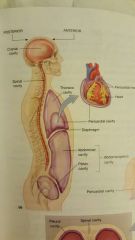
Dorsal, ventral, cranial, spinal |
|
|
|
Viscera |
Moist membrane that helps control the spread of infections and keeps organs moist and lubricated |
|

